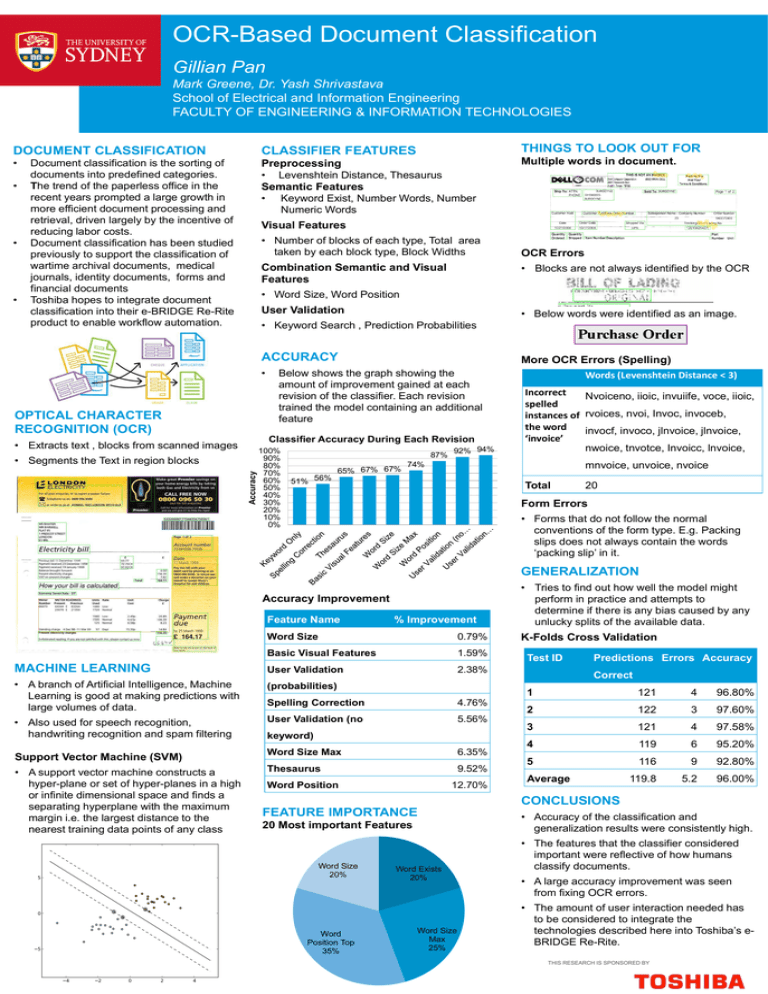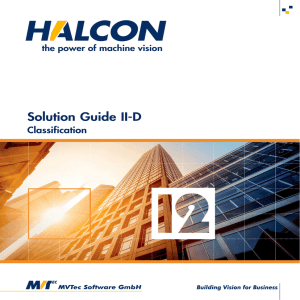OCR-Based Document Classification
advertisement

OCR-Based Document Classification Gillian Pan Mark Greene, Dr. Yash Shrivastava School of Electrical and Information Engineering FACULTY OF ENGINEERING & INFORMATION TECHNOLOGIES DOCUMENT CLASSIFICATION CLASSIFIER FEATURES THINGS TO LOOK OUT FOR • Preprocessing • Levenshtein Distance, Thesaurus Semantic Features • Keyword Exist, Number Words, Number Numeric Words Multiple words in document. • • • Document classification is the sorting of documents into predefined categories. The trend of the paperless office in the recent years prompted a large growth in more efficient document processing and retrieval, driven largely by the incentive of reducing labor costs. Document classification has been studied previously to support the classification of wartime archival documents, medical journals, identity documents, forms and financial documents Toshiba hopes to integrate document classification into their e-BRIDGE Re-Rite product to enable workflow automation. Visual Features • Number of blocks of each type, Total area taken by each block type, Block Widths OCR Errors • Blocks are not always identified by the OCR Combination Semantic and Visual Features • Word Size, Word Position User Validation • Below words were identified as an image. • Keyword Search , Prediction Probabilities ACCURACY • OPTICAL CHARACTER RECOGNITION (OCR) Below shows the graph showing the amount of improvement gained at each revision of the classifier. Each revision trained the model containing an additional feature Classifier Accuracy During Each Revision • Extracts text , blocks from scanned images Accuracy • Segments the Text in region blocks 100% 90% 80% 70% 60% 50% 40% 30% 20% 10% 0% 87% 65% 67% 67% 92% 94% More OCR Errors (Spelling) Words (Levenshtein Distance < 3) Incorrect Nvoiceno, iioic, invuiife, voce, iioic, spelled instances of rvoices, nvoi, Invoc, invoceb, the word invocf, invoco, jlnvoice, jlnvoice, ‘invoice’ nwoice, tnvotce, Invoicc, lnvoice, 74% mnvoice, unvoice, nvoice 51% 56% Total 20 Form Errors • Forms that do not follow the normal conventions of the form type. E.g. Packing slips does not always contain the words ‘packing slip’ in it. GENERALIZATION Accuracy Improvement Feature Name % Improvement Word Size 0.79% Basic Visual Features 1.59% MACHINE LEARNING User Validation 2.38% • A branch of Artificial Intelligence, Machine Learning is good at making predictions with large volumes of data. (probabilities) Spelling Correction 4.76% • Also used for speech recognition, handwriting recognition and spam filtering User Validation (no 5.56% keyword) Support Vector Machine (SVM) Word Size Max • A support vector machine constructs a hyper-plane or set of hyper-planes in a high or infinite dimensional space and finds a separating hyperplane with the maximum margin i.e. the largest distance to the nearest training data points of any class Thesaurus 6.35% 9.52% Word Position 12.70% • Tries to find out how well the model might perform in practice and attempts to determine if there is any bias caused by any unlucky splits of the available data. K-Folds Cross Validation Test ID Predictions Errors Accuracy Correct 1 121 4 96.80% 2 122 3 97.60% 3 121 4 97.58% 4 119 6 95.20% 5 116 9 92.80% 119.8 5.2 96.00% Average CONCLUSIONS FEATURE IMPORTANCE 20 Most important Features Word Size 20% Word PositionISTop THIS RESEARCH SP 35% Word Exists 20% Word Size Max 25% • Accuracy of the classification and generalization results were consistently high. • The features that the classifier considered important were reflective of how humans classify documents. • A large accuracy improvement was seen from fixing OCR errors. • The amount of user interaction needed has to be considered to integrate the technologies described here into Toshiba’s eBRIDGE Re-Rite. THIS RESEARCH IS SPONSORED BY



